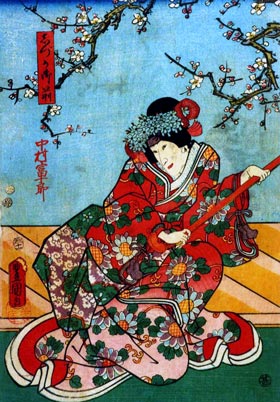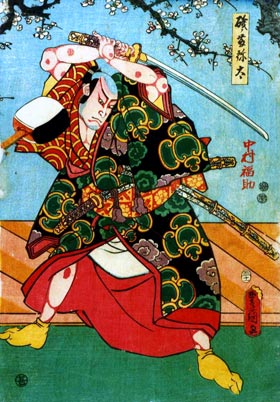| TďYATA MONOGATARI |
| Play title | Gosho Zakura Horikawa no Youchi Imperial Palace Cherry Blossoms and the Horikawa Night Attack [1] |
| Authors | Matsuda Bunk˘d˘ Miyoshi Sh˘raku |
| History |
The play "Gosho Zakura Horikawa no Youchi" was originally written for the puppet theater (Bunraku) and staged for the first time in the 1st lunar month of 1737 in ďsaka at the Takemotoza. It was adapted for Kabuki many years later and staged for the first time in the 4th lunar month of 1762 in ďsaka at the Naka no Shibai [casting]. The roles of Iso no T˘yata and Shizuka Gozen were played by Fujikawa Hachiz˘ I and Nakamura Kumetar˘ I. The "T˘yata Monogatari" scene was produced only a few times during the Edo period. "T˘yata Monogatari" was revived in 1947 by Band˘ Mitsugor˘ VII and, from this date, the role of Iso no T˘yata is closely related to the Band˘ Mitsugor˘ line of actors. This drama was staged only 5 times since the end of WII (5 times over 50 years, once every ten years!): |
| Structure |
"Gosho Zakura Horikawa no Youchi" is a 5-act maruhonmono. The "T˘yata Monogatari" scene belongs to the fourth act. |
| Key words |
Genpei Kassen Genpei-kassenmono Genji Gidayű Ky˘gen Hana Yoten Heike Horikawa Horikawa Horikawa Gosho Jidaimono Kajiwara Kagetaka Kajiwara Kagetoki Koshimoto Ky˘-no-Kimi Migawari Migawarimono Minamoto Yoshitsune Modori Monogatari Musashib˘ Benkei Obi Seishitsu Shamisen Shiraby˘shi Sokushitsu Tachimawari Tsuzumi |
| Summary |
After having been saved once through the secret substitution of Musashib˘ Benkei's daughter Shinobu in her stead, Ky˘-no-Kimi, Yoshitsune's seishitsu, has continued to live at the Horikawa Palace, this time disguised as the koshimoto Shinobu, who has been sacrificed to save her. In the meantime, in order to forestall further suspicion, Yoshitsune has installed his mistress (sokushitsu), the shiraby˘shi Shizuka Gozen, as his official wife following Ky˘-no-Kimi's "death." To complete the picture, he has also called Shizuka Gozen's mother, a famous dance teacher who is called Iso no Zenji [2], to come to live at the mansion too. This results in a situation in which the real wife is serving as koshimoto to the "substitute" wife, but whenever circumstances permit, Shizuka Gozen in the privacy of the inner quarters, tends solicitously to the needs of the real mistress of the household, much to Ky˘-no-Kimi's gratitude. Such is the situation one day when Shizuka Gozen's brother Iso no T˘yata Yoshiharu comes to the mansion. He is an evil man whose bad ways have caused him to be disowned by his father, but he has once chanced to save Ky˘-no-Kimi's mother from danger at the hand of the Kajiwaras [3] on the way back from a pilgrimage at the Ise Shrine. As a result of this deed, he has escorted the mother home to Horikawa and been presented with a sword from Yoshitsune in sign of gratitude. However, being a bad man at heart, he has been tied up with the Kajiwaras, and has come to the Horikawa Palace to spy out whether Ky˘-no-Kimi has really been killed as reported. He comes to the room where Shizuka is with Ky˘-no-Kimi disguised as Shinobu, and immediately suspects the real relationship between the two women. While recounting episodes from the pilgrimage trip from which he has just returned, he closely observes the two women, and reaches the conclusion that the koshimoto Shinobu who is at the service of his sister Shizuka Gozen, must be none other than Ky˘-no-Kimi herself. As a means of testing his conjecture, he pretends to have become infatuated with her, and starts making amorous motions toward her. Shizuka Gozen is aghast that he should take such liberty with the wife of Yoshitsune and unthinkingly gasps a warning which serves to confirm T˘yata's suspicion. Shizuka Gozen realizes her slip and tries to cover up as she quickly leaves the room accompanied by Ky˘-no-Kimi. But T˘yata is already convinced that Shinobu is Yoshitsune's seishitsu Ky˘-no-Kimi in disguise, and quickly writes a message to be delivered to the Kajiwaras. Shizuka Gozen, who in the meantime has returned to the room, bringing with her this time her shamisen, sees him writing the letter and questions him about it sharply. T˘yata replies that it is a love letter to Shinobu, but Shizuka challenges him, saying it is not love that is prompting him to write the letter, but greed for a reward. T˘yata, seeing that it is useless to deny the truth, says he is sure Shinobu is Ky˘-no-Kimi, and that he has seen the maternity belt she was wearing which further confirmed his suspicion. Shizuka Gozen is alarmed at this revelation, but says that T˘yata must repent his bad ways immediately and have a change of heart by the time their mother Iso no Zenji who is performing a dance in another room, finishes her performance. T˘yata, however, refuses to listen to her pleas and tries to push his way out to inform the Kajiwaras. Shizuka tries to stop him by force, but T˘yata impatiently draws his sword and slashes at her. Shizuka parries with her shamisen and puts up a good fight, but of course is no match for him. T˘yata demands that she follows his will or he will kill her. At this point, Iso no Zenji comes to the room in great haste, still wearing her dance costume. She stabs her own son T˘yata, inflicting a mortal wound. Then she vehemently chastises T˘yata, saying she has taken over the duty of his father who has disowned him and then waited in vain for him to mend his ways before the father's death. But T˘yata had only gone from bad to worse. Now she calls on him to repent, with some consideration for the feelings of his mother, and starts to weep bitterly. At this, T˘yata finally has a change of heart (modori). He confesses in a long monogatari that he has come to the Horikawa Palace to check on Ky˘-no-Kimi for the Kajiwaras, and reveals that they are plotting an attack on the mansion that night with a troupe of warriors led by their main henchman Banba no Chűta. As the sound of the approaching enemy is heard, T˘yata dresses himself with the dance garment discarded by his mother, and uses his sister's obi to bind his wound. Then, while Shizuka plays on a tsuzumi drum and performs a dance to fool the enemy, T˘yata pushes out against the enemy, a group of hana yoten, and puts up a great fight (tachimawari), routing them from the mansion. Then he dies in his sister Shizuka Gozen's arms. |
| Notes |
[1] The title "Imperial Palace Cherry Blossoms and the Horikawa Night Attack" comes from Samuel Leiter's "Historical Dictionary of Japanese Traditional Theatre". [2] It was the name of her late husband. [3] The two evil Kajiwaras in "Gosho Zakura Horikawa no Youchi", who appeared in the first act, were Kajiwara Heiz˘ Kagetoki and his son Kajiwara Heiji Kagetaka. |
 |
 |
|
The actors Nakamura Tomijűr˘ II and Nakamura Fukusuke I playing the roles of Shizuka Gozen and Iso no T˘yata Yoshiharu in the "T˘yata Monogatari" scene of the drama "Gosho Zakura Horikawa no Youchi",
which was staged in the 11th lunar month of 1853 at the Ichimuraza |
|
|
|
| Contact | Main | Top | Updates | Actors | Plays | Playwrights | Programs | Links | FAQ | Glossary | Chronology | Illustrations | Prints | Characters | Derivatives | Theaters | Coming soon | News |